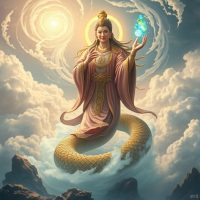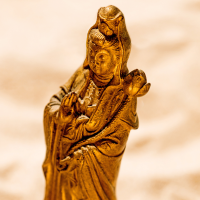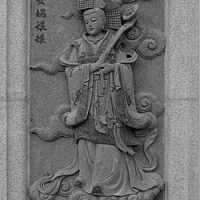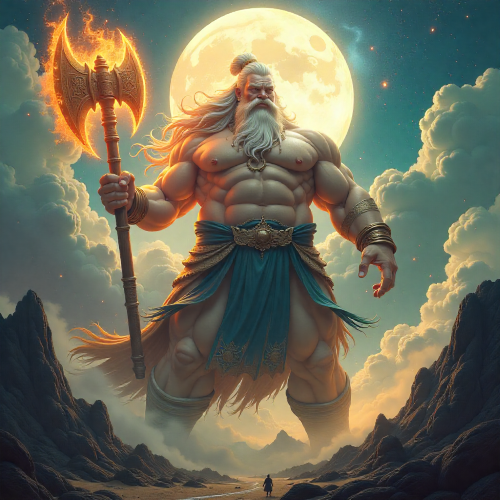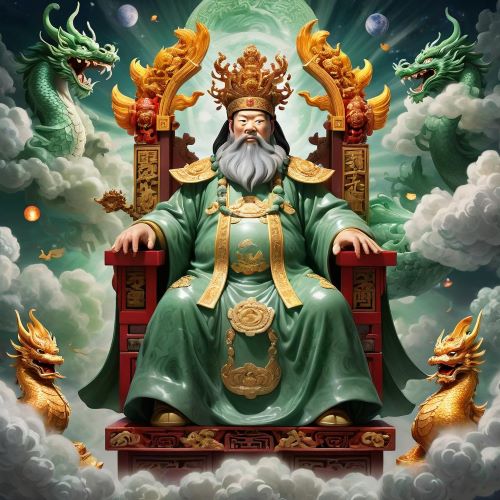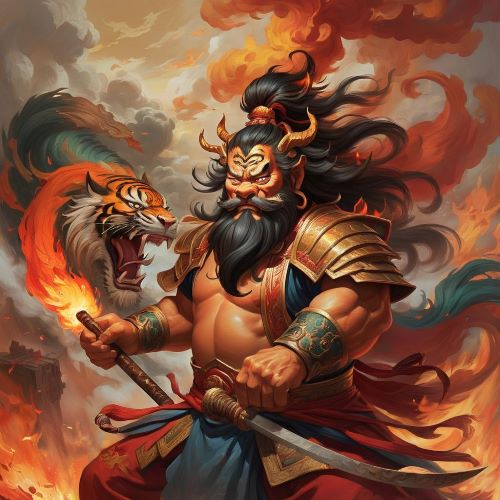Nuwa : China’s Great Creator Goddess
Listen
At a glance
| Description | |
|---|---|
| Origin | Chinese Mythology |
| Classification | Gods |
| Family Members | Fuxi (Brother) |
| Region | China |
| Associated With | Creation |
Nuwa
Introduction
Nuwa (女娲) stands among the most beloved and powerful deities in Chinese mythology, revered as both the creator of humankind and the restorer of the cosmos. Her legend, preserved in classical texts such as the Shan Hai Jing (Classic of Mountains and Seas) and Huainanzi, describes a compassionate goddess who shaped humanity from clay and repaired the heavens after a celestial disaster. Through her myths, ancient Chinese culture expressed its understanding of creation, harmony, and resilience—values that continue to resonate today. Nuwa’s story remains a cornerstone of Chinese cosmology, symbolizing divine creativity and the balance between heaven, earth, and humankind.
Physical Traits
Nuwa is traditionally portrayed with the upper body of a beautiful woman and the lower body of a serpent or dragon. This dual form embodies her connection to both the divine heavens and the natural earth, reflecting her role as a bridge between cosmic and mortal realms. Her serpentine tail represents fertility, life force, and cyclical renewal—key themes in early Chinese thought. Many depictions show Nuwa intertwined with her consort, Fuxi, holding the compass and square—tools symbolizing creation, geometry, and universal order. In other artistic renderings, she is seen melting five-colored stones to repair the sky, her luminous figure surrounded by a celestial glow. Her hybrid form captures the mystical power of a being who exists beyond the limitations of either human or god.ands made her a constant presence in both domestic and ritual spaces, ensuring protection and prosperity for families and mothers-to-be.
Family
In mythic tradition, Nuwa shares her divine lineage with Fuxi, who is variously described as her brother, husband, or both—a reflection of the myth’s ancient origins when familial and cosmic relationships overlapped. Together, Nuwa and Fuxi are regarded as the first sovereigns of humanity and progenitors of civilization. They are credited with teaching humans essential knowledge—how to hunt, fish, weave nets, play music, and establish marriage rituals. Some accounts describe them as born from the Earth goddess Huaxu, emerging after the great chaos that preceded the world’s formation. Their union represents the balance of yin and yang, feminine and masculine, creativity and structure—the dual forces necessary for the maintenance of universal harmony.
Other names
Nuwa’s reverence transcends linguistic and cultural boundaries, and her name appears in multiple forms across East and Southeast Asia. In Chinese, she is known as Nǚwā or Nügua (女媧), while in Vietnam she is remembered as Nữ Oa, in Korea as Yeowa (여와), and in Japan as Joka (じょか). Ancient texts also refer to her as Wahuang (媧皇), meaning “Empress Wa,” emphasizing her regal stature. In certain Taoist traditions, she is honored as the “Mother Goddess” or “Heavenly Queen,” titles that underscore her maternal role in creation. These diverse appellations reveal her widespread cultural significance and the adaptability of her myth within different philosophical and religious frameworks.
Powers and Abilities
Nuwa’s divine abilities are centered on creation, restoration, and the preservation of cosmic order. Her most enduring tale recounts how she created humankind from yellow clay, shaping figures with her hands and breathing life into them. To populate the earth more quickly, she later used a rope to fling droplets of clay, which became common people—a myth that symbolically explains social diversity while affirming equality through shared divine origin.
Her greatest act, however, came after the gods Gong Gong and Zhu Rong battled and shattered the pillars of heaven. With the sky torn and floods consuming the earth, Nuwa melted five-colored stones to mend the celestial dome and used the legs of a giant turtle to replace the broken pillars supporting the heavens. She quelled the raging waters and restored balance, saving both gods and mortals from annihilation.
In some versions, Nuwa also subdued monstrous beasts and controlled floods, using reeds and ash to stabilize the land—acts that foreshadow the later hydraulic engineering legends of Yu the Great. Her powers were not rooted in destruction or dominance but in healing and regeneration, qualities that set her apart as a divine mother who nurtures rather than conquers. Through these deeds, she became the archetype of creation and compassion, ensuring the stability of heaven and earth.
Modern Day Influence
Nuwa’s influence continues to permeate modern Chinese culture and beyond. She remains a symbol of maternal strength, compassion, and the capacity to rebuild after chaos. Temples dedicated to her, such as those in Anhui and Hebei provinces, still draw devotees who pray for fertility, harmony, and protection. Her myth has inspired centuries of literature and art, from Han dynasty carvings and Tang murals to contemporary novels, films, and video games.
In philosophy and modern thought, Nuwa’s story has been reinterpreted as a parable of ecological consciousness and human responsibility. The act of repairing the sky with multicolored stones is seen as an allegory for sustainable restoration—healing the natural world rather than exploiting it. Feminist scholars and artists also view Nuwa as a representation of ancient matriarchal power, emphasizing balance and care in governance, contrasting with the later patriarchal systems that dominated Chinese society.
Nuwa’s presence is also felt in popular culture and digital media. She appears as a character in games like Smite and Chinese Paladin, often depicted as a guardian deity or elemental creator. Her legend has been adapted into animated films and television dramas that celebrate her as a heroine of compassion and wisdom. Beyond China, East Asian mythology enthusiasts in Korea, Japan, and Vietnam continue to revere her as a goddess who embodies unity and creation across cultures.
In modern spiritual movements, Nuwa is sometimes invoked as a universal mother figure, symbolizing the creative potential within all beings. Her mythology encourages balance between human innovation and natural preservation—a message increasingly relevant in an era of environmental crisis.
Related Images
Source
Wild Great Wall. (2025, October 9). Meet Nuwa: China’s Legendary Mother & First Sculptor of Man! Retrieved from https://wildgreatwall.com/nuwa-china-legendary-mother/
Mythology.Top. (2025, June 1). Nuwa – Creator of Humans [Chinese Mythology]. Retrieved from https://mythology.top/nuwa-creator-of-humans-chinese-mythology/
The Bump. (2024, February 6). Nuwa – Baby Name Meaning, Origin and Popularity. Retrieved from https://www.thebump.com/b/nuwa-baby-name
New World Encyclopedia. (2006, December 31). Nuwa – New World Encyclopedia. Retrieved from https://www.newworldencyclopedia.org/entry/Nuwa
The Elemental Mind. (2025, January 30). Nuwa: The Goddess Who Created Humanity and Repaired the Sky. Retrieved from https://theelementalmind.com/2025/01/31/nuwa-the-goddess-who-created-humanity/
MomJunction. (2024, June 13). Nuwa Name Meaning, Origin, History, And Popularity. Retrieved from https://www.momjunction.com/baby-names/nuwa/
PDF: Ancestor of Mankind in Folklore—Nuwa. Retrieved from https://upload.wikimedia.org/wikipedia/commons/a/ae/Ancestor_of_Mankind_in_Folklore%E2%80%94%E2%80%94Nuwa.pdf
Clausius Press. (2024, July 17). A New Exploration of Nu Wa Creation of Man. Retrieved from https://clausiuspress.com/assets/default/article/2024/07/17/article_1721206117.pdf
Frequently Asked Questions
Who is Nuwa in Chinese mythology?
Nuwa is the ancient creator goddess who shaped humanity from clay and repaired the heavens after a cosmic catastrophe, ensuring the survival of the world.
What is Nuwa famous for?
She is best known for creating humans and fixing the broken sky by melting colorful stones to restore cosmic order.
What does Nuwa look like?
Nuwa is often depicted as a woman with a serpent or dragon lower body, symbolizing creation, transformation, and divine power.
Who is Nuwa’s companion or spouse?
Many legends pair Nuwa with Fuxi, her brother and partner, who taught humans essential skills like writing and fishing.
How is Nuwa honored today?
Nuwa remains a respected goddess in Chinese folk religion and Taoist traditions, with temples, art, and festivals celebrating her as the mother of humanity.


